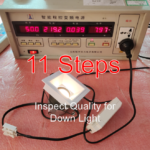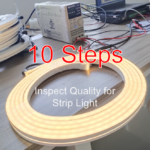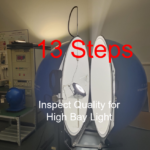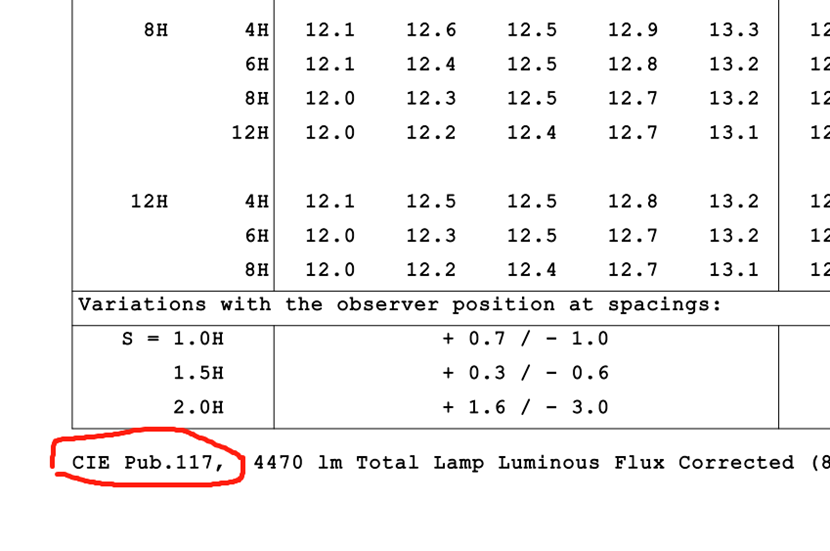Recently, a new customer from France contacts us.
They need our help to do the IES light distribution test for their LED office lights.
Their purchase person in China tells me that they need the documents as below:
- IES file (.IES)
- Photometric report
- Spectrum report
And UGR table on the photometric report needs to follow CIE-190:201.
In short, these tests are the Spectrum test and IES test in the LM79 test.
This is a routine test for us.
It’ll be very simple for us, and the procedures will be as below:
- The customer sends us the light.
- We receive the sample and test it (almost with our eyes closed).
- Then we send the test data to the customer.
However, I notice a point in the customer’s requirements.
- UGR table on the photometric report needs to follow CIE-190:201.
In my experience, this must be the key point since the client specifically mentions it.
It is also very likely that other testing organizations can’t do it.
So, we reply to the customer:
Please wait, let us confirm the test standard.
Shortly, our test engineer gives me a reply.
Currently, our UGR tests are done according to another standard CIE Pub.117.
This is by default in the system.
So, I ask the customer:
- Can we do this test according to the standard in this screenshot?
Then we receive a quick response from France.
Hank, CIE.117 is no longer enough for French Market.
CIE-190:201 is now mandatory!
Well, it really doesn’t work!
I’ve been in business for so long that I have had a magical sixth sense.
A customer will not raise a test requirement for no reason.
If they do specify it, we must spend some time studying.
Of course, I’m happy that customers raise such requirements.
It’s obvious that this will push us to continuously improve our capabilities.
So why don’t we do that?
So, I reply to the customer.
Let me talk with the test instrument maker.
I contact the support team of our IES test instrument supplier.
Fortunately, the support person answers:
You just need to locate an option in the software.
Then config it and it will work.
That’s great.
We modify the software’ setting immediately following the advice of their support team.
The result?
The interface of the software is different from the one described by the support team!
Well, many things will not go smoothly!
We always have to pay more to get them done!
So, I ask the instrument maker’s support person.
How come the software interface is different from what you said?
That guy replies:
Your test software needs to be updated!
At this point, I’m tight in mind.
Frankly speaking, I don’t want to spend CNY20,000 updating the software or hardware.
Just for the sake of hundreds of fees for new customers.
So, I ask the instrument maker 2 questions:
- Just the software that needs to be updated, and how much does it cost?
- Does the hardware need to be replaced, and how much does it cost?
Fortunately, the maker gives me a clear answer.
You will need to update the software only, and it’s free.
Contact me tomorrow morning.
And I will send you the new software and tell you how to install it.
Awesome!
It’s another half day’s hard work and phone calls back and forth.
We finally get the new software installed and running.
Inside the new software, we can set the standard for UGR forms: CIE190:2010.
We test a light with the new software.
And the UGR table shows that it is already CIE190:2010.
We need to make sure updating the software won’t have negative influence on results’ accuracy.
Our engineer tests one of the previously measured floodlights again.
The accuracy fluctuation is within the tolerance.
So, I tell this French customer “We can meet your UGR test requirements.”
And send her a screenshot of our UGR test.
Next, all we can do is wait for feedback from our French customer.
However, there is something even more meaningful.
That is we have gained new experience while satisfying our customer’s requirements.
These competencies will be helpful for our services to other clients.
In fact, that’s why BackMorning insists on working with demanding customers.
It’s a great way for us to continuously improve our service!
Now it has come to the end of this story.
What do you think of it?
Please leave us a comment and let us know your thoughts.
We have many more stories.
And always more than happy to share them with you.
Related posts:
 Two Tips for Buying Good Quality LED Lights
Two Tips for Buying Good Quality LED Lights
 Comparing LED Streetlights with Different IK Ratings
Comparing LED Streetlights with Different IK Ratings
 12 Steps to Inspect LED Linear Lights before Shipment
12 Steps to Inspect LED Linear Lights before Shipment
 11 Steps to Inspect LED Down Lights before Shipment
11 Steps to Inspect LED Down Lights before Shipment
 10 Steps to Inspect LED Strip Lights before Shipment
10 Steps to Inspect LED Strip Lights before Shipment
 13 Steps to Inspect LED High Bay Lights before Shipment
13 Steps to Inspect LED High Bay Lights before Shipment






